Electric Vehicle Sensor Market Size
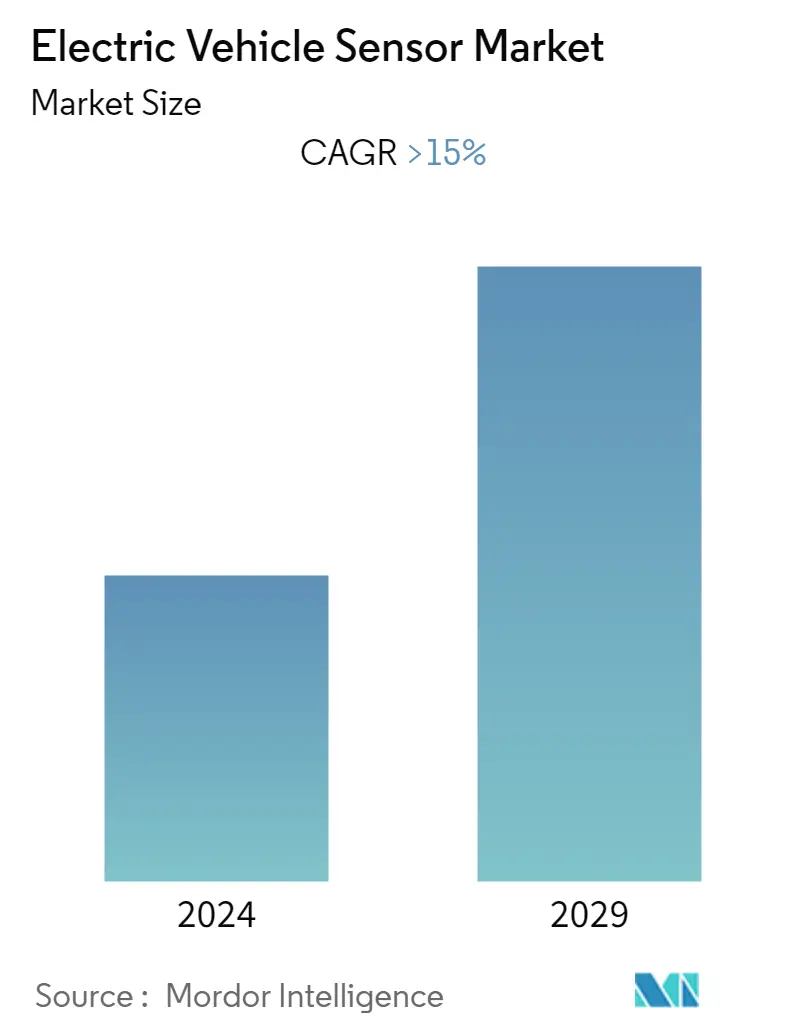
| Study Period | 2019 - 2029 |
| Base Year For Estimation | 2023 |
| CAGR | 15.00 % |
| Fastest Growing Market | North America |
| Largest Market | Asia-Pacific |
| Market Concentration | Medium |
Major Players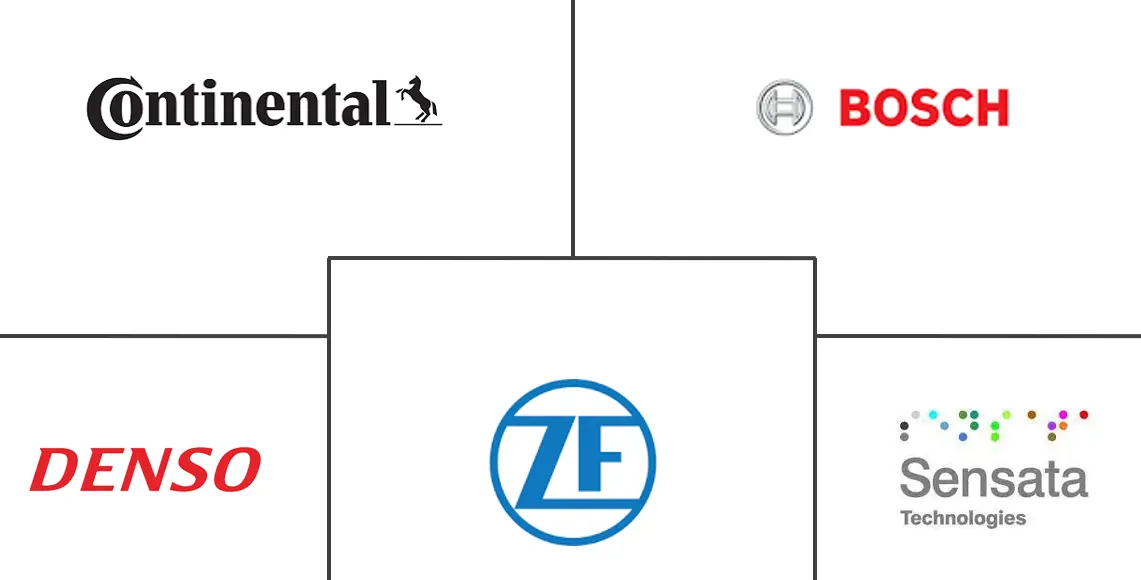
*Disclaimer: Major Players sorted in no particular order |
Electric Vehicle Sensor Market Analysis
The electric vehicle sensor market is expected to reach USD 20.09 billion, registering a CAGR of 15% over the next five years.
The COVID-19 pandemic and associated bottlenecks in the supply chain hampered the electric vehicle manufacturing supply chain during the first half of 2020. However, as the lockdown measures were eased, the demand for electric vehicles started picking up pace. In 2020, electric vehicle sales (battery electric vehicles) witnessed an increase of around 33%, which continued in 2021. Such growth in electric vehicle sales is anticipated to drive the demand for a variety of sensors. These sensors include sensors associated with battery management, driver assistance systems, active and passive safety systems, etc.
Over the long term, the growing use of semi-automated and automated vehicles in transportation and logistics will spur the development of electric vehicle sensors. Many prominent players are integrating various sensors such as radar, image, LiDAR, and infrared to improve road safety and autonomous mobility. Growing concerns about the safety of autonomous vehicles have led governments to accept and adopt them across the world. One of the key factors driving market demand is the increasing use of sensors in autonomous vehicles. The increased use of image sensors, temperature sensors, position sensors, and speed sensors in ADAS/AD systems will boost the market growth as the electric vehicle demand is anticipated to be driven by the development of autonomous and semi-autonomous vehicles.
Due to restraining factors like the high cost of electric vehicles, along with a shortage of semiconductors, the market faces challenges.
In the coming years, the European electric vehicle sensor market is anticipated to grow significantly, attributing to the rising demand for cutting-edge technologies, like IoT and AI, in the automotive sector for electric mobility. To ensure passenger safety, systems like ADAS (Advanced Driver Assistance Systems) and EBD (Electronic Brake Force Distribution) are increasingly incorporated into electric vehicles, which further supports product acceptance. Furthermore, the policy environment still drives the uptake of electric vehicles. The 10 leading countries, such as China, the United States, Norway, Germany, the United Kingdom, France, Sweden, and the Netherlands, in electric vehicle adoption have a range of policies to promote the uptake of electric vehicles.
Governments are implementing initiatives and reforms, with heavy investments in the electric vehicles sector, to boost demand and encourage the adoption of electric vehicles in their countries worldwide. In August 2021, the United Kingdom government promised to invest GBP 20 million in projects that help develop zero-emission heavy goods vehicles (HGVs). The Department for Transport (DfT) estimates that the money may help increase the number of zero-emission HGVs on UK roads and improve the infrastructure for such vehicles.
Electric Vehicle Sensor Market Trends
This section covers the major market trends shaping the Electric Vehicle Sensor Market according to our research experts:
INCREASE IN PRODUCTION OF SEMI AUTONOMOUS PASSENGER VEHICLES FOSTER THE DEMAND OF ELECTRIC VEHICLE SENSOR MARKET
The demand for autonomous and semi-autonomous vehicle technologies has increased as a result of growing safety and security concerns among consumers. Some potential advantages of autonomous and semi-autonomous vehicles include reduced vehicle accidents, improved fuel efficiency, and increased engine productivity. Price reductions of this magnitude, such as those experienced by LIDAR (whose price dropped from USD 75,000 to USD 7,500), are expected to accelerate market expansion.
Segmental growth will be fueled by rising demand for automotive electrification and the incorporation of cutting-edge safety and infotainment systems into vehicles. To ensure that EV batteries are used to their full potential, these systems employ a variety of powertrain sensors, including those that measure temperature, speed, position, current, and ultrasonics.
Additionally, sensors are increasingly used in ADAS and automated driving to provide more critical information about a vehicle's surroundings as improved sensors for connected and autonomous infrastructure becomes available. Smart automobiles and luxury vehicles will also drive demand for automotive sensors. The increasing popularity of electric vehicles is also increasing the demand for sensors. Non-contact 3D magnetic sensors are being encouraged by vehicle manufacturers to replace potentiometers or optical systems that leverage traditional position-sensing techniques. These sensors minimize wear and contamination, reduce space, and provide accurate readings in high-temperature environments. Moreover, pressure sensors are becoming an essential component of engine and safety systems. When the accelerator or brake pedals are depressed, the sensors within the engine monitor the oil and coolant pressures and control the power that the engine produces. This allows the engine to maintain the desired speed.
Furthermore, in terms of safety features, pressure sensors are a crucial component of the anti-lock braking system (ABS). This technology adjusts to the road surface and guarantees that while stopping at high speeds, the tires do not lock, and the car does not slide. The pressure sensors in ABS inform the processor of road conditions and the vehicle's speed. Dubai has stated that by 2030, 10% of all vehicles will be electric or hybrid, and by 2050, the city-state will be the first in the region to be emission-free. In line with this, the government is attempting to electrify its public fleet, with the Dubai RTA focusing on expanding its fleet of electric vehicles.
In February 2021, MG Motors launched the latest model of MG ZS EV in India. The ZS EV was launched in India as the brand's second model in the market. It was also introduced as the brand's first all-electric vehicle. The ZS EV is equipped with a 44.5 kWh battery pack, which MG claims is good enough for 350 km of driving range on a single charge.
Such growth in government support, announcements by governing bodies and OEMs to halt manufacturing and sales of fossil fuel-powered vehicles, and availability of cost-friendly electric vehicle models are anticipated to drive the market in focus during the forecast period.
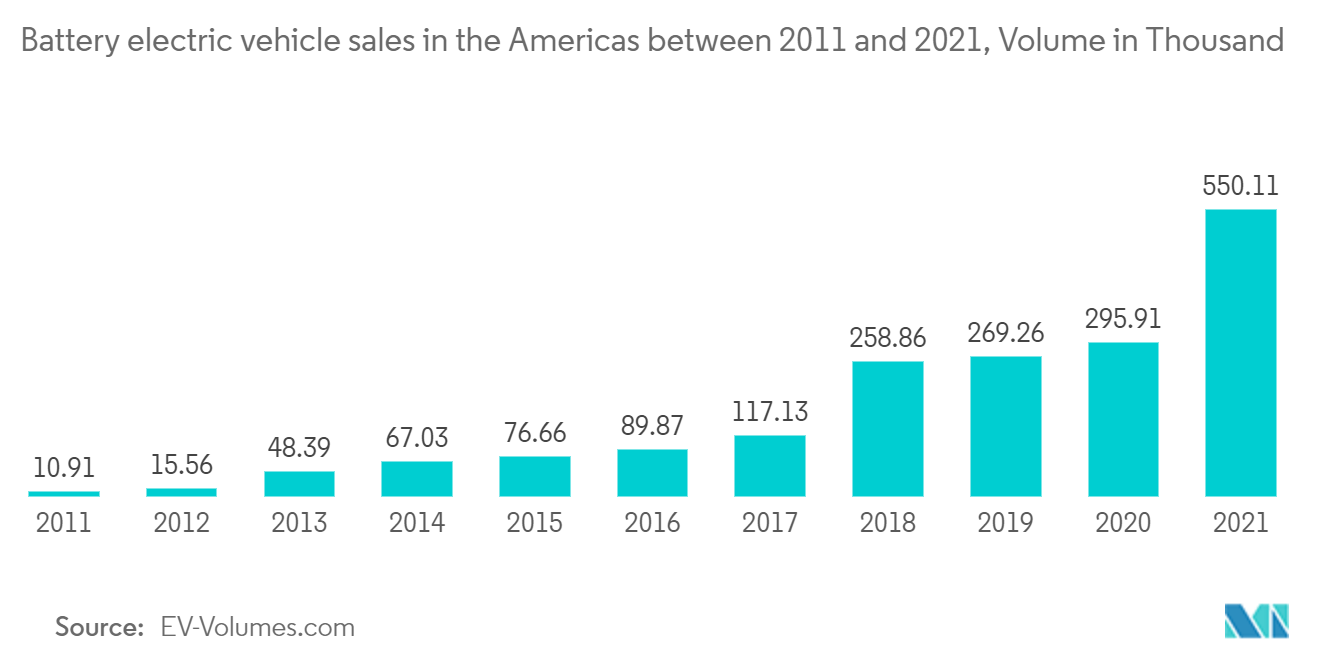
ASIA-PACIFIC REGION IS EXPECTED TO HOLD THE HIGH MARKET SHARE IN THE ELECTRIC VEHICLE SENSOR MARKET
In Asia-Pacific, the growing adoption of HEVs and rising air pollution levels caused by vehicle exhaust emissions are important factors positively affecting the target market. This can also be attributed to rising urbanization, increased individual purchasing power, and improved road networks. In developing countries such as India, the market for HEVs is expanding because of large sales volumes in the Indian market. Hybrid vehicles are also deployed to meet increasingly strict emission rules since they are less expensive than PHEVs and EVs. Furthermore, several top automakers are boosting their investments in research and development (R&D) activities to create novel automobiles with noiseless operations, high-performance engines, and enhanced fuel efficiency. This, together with the rising trend of fuel-efficient and cost-effective travel options, is producing a positive market picture. Moreover, factors such as stringent government laws on vehicle emissions have increased the demand for high-performance, fuel-efficient, and low-emission vehicles, and lower battery costs contribute to the growth of the electric vehicle industry. Technical developments, aggressive government efforts, and the development of self-driving electric vehicle technology are likely to generate several possibilities for major players in the electric vehicle market.
In May 2022, with the new City e: HEV, Honda launched its advanced intelligent safety technology, "Honda SENSING", for the first time in India. By 2050, the company aims to achieve carbon neutrality and zero traffic fatalities globally. The Honda CITY e: HEV uses an AC synchronous (permanent magnet) electric drive motor.
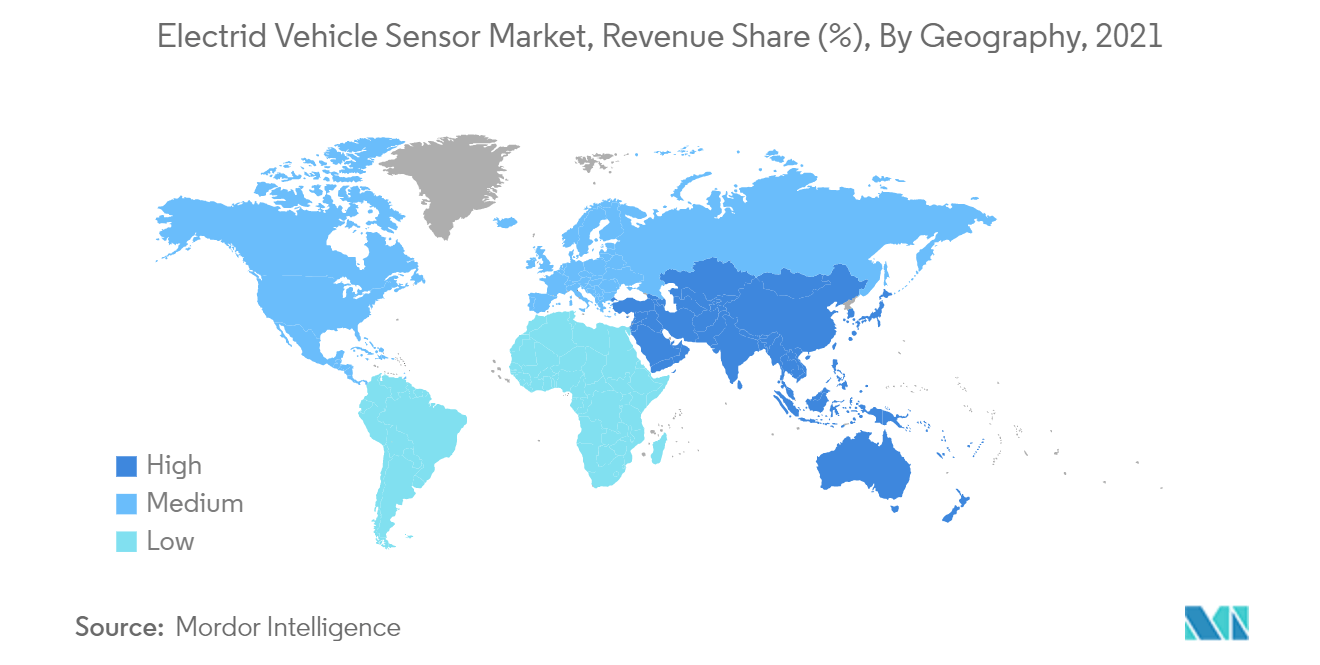
Electric Vehicle Sensor Industry Overview
The global electric vehicle sensor market is moderately consolidated, with major players holding a significant share of the market. The electric vehicle sensor industry is adopting various industries, including new product development and expansion across the globe. OEM companies use the latest features and technologies to manufacture tires that meet the needs of customers. For instance,
- In July 2022, the Current Sensing Module (CSM) and Battery Impact Detection were the two sensors introduced by Continental. Both of them provide vital data to the battery management system, which aids in safeguarding and enhancing the operation of the energy module.
- In July 2022, Valeo Wemding was at the forefront of the autonomous mobility revolution and recently won major contracts with automakers Stellantis and BMW. The company produces innovative sensors that enable autonomous driving and increase road safety.
Electric Vehicle Sensor Market Leaders
-
Continental AG
-
Robert Bosch GmbH
-
ZF Friedrichshafen AG
-
Denso Corporation
-
Sensata Technologies, Inc.
*Disclaimer: Major Players sorted in no particular order
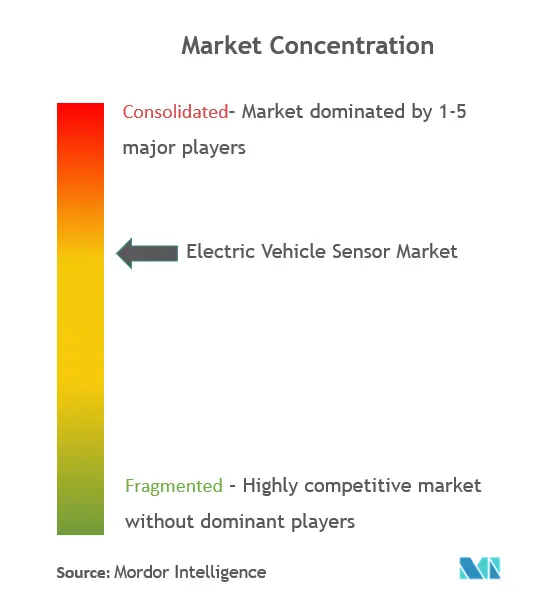
Electric Vehicle Sensor Market News
- In September 2022, according to its creators, Mutsuko Hatano, at the Tokyo Institute of Technology and her colleagues in Japan, a new quantum sensor can measure the energy stored in electric vehicle batteries much more precisely than existing devices. The range and energy efficiency of electric vehicles could be significantly increased owing to their sensor, which uses nitrogen-vacancy (NV) centers in diamonds.
- In March 2022, Nissan fitted multiple sensors to dummy passengers to assess the effects of a collision involving its upcoming Ariya electric crossover SUV. Human safety is only one of the extensive tests performed on Nissan's new vehicles. Every vehicle is subjected to rigorous crash tests, including frontal, side, and rear-impact collisions and those that simulate accidents involving pedestrians on the road. A team of engineers at the Nissan Technical Center in Atsugi, Japan, work tirelessly to ensure that Nissan vehicles, including the upcoming Ariya electric crossover SUV, have a high level of safety in the event of a collision.
Electric Vehicle Sensor Market Report - Table of Contents
1. INTRODUCTION
- 1.1 Study Assumptions
- 1.2 Scope of the Study
2. RESEARCH METHODOLOGY
3. EXECUTIVE SUMMARY
4. MARKET DYNAMICS
- 4.1 Market Drivers
- 4.2 Market Restraints
-
4.3 Industry Attractiveness - Porter's Five Forces Analysis
- 4.3.1 Threat of New Entrants
- 4.3.2 Bargaining Power of Buyers/Consumers
- 4.3.3 Bargaining Power of Suppliers
- 4.3.4 Threat of Substitute Products
- 4.3.5 Intensity of Competitive Rivalry
5. MARKET SEGMENTATION (Market Value in Billion)
-
5.1 Sensor Type
- 5.1.1 Current Sensor
- 5.1.2 Temperature Sensor
- 5.1.3 Position Sensor
- 5.1.4 Pressure Sensor
- 5.1.5 Other Sensor Types
-
5.2 Vehicle Type
- 5.2.1 Passenger Cars
- 5.2.2 Commercial Vehicle
-
5.3 Propulsion Type
- 5.3.1 Battery Electric Vehicle
- 5.3.2 Plug-in Hybrid Electric Vehicle
- 5.3.3 Fuel Cell Electric Vehicle
-
5.4 Geography
- 5.4.1 North America
- 5.4.1.1 United States
- 5.4.1.2 Canada
- 5.4.1.3 Rest of North America
- 5.4.2 Europe
- 5.4.2.1 Germany
- 5.4.2.2 United Kingdom
- 5.4.2.3 France
- 5.4.2.4 Italy
- 5.4.2.5 Spain
- 5.4.2.6 Rest of Europe
- 5.4.3 Asia-Pacific
- 5.4.3.1 China
- 5.4.3.2 Japan
- 5.4.3.3 India
- 5.4.3.4 South Korea
- 5.4.3.5 Rest of Asia-Pacific
- 5.4.4 South America
- 5.4.4.1 Brazil
- 5.4.4.2 Argentina
- 5.4.4.3 Rest of South America
- 5.4.5 Middle East and Africa
- 5.4.5.1 United Arab Emirates
- 5.4.5.2 Saudi Arabia
- 5.4.5.3 South Africa
- 5.4.5.4 Rest Of Middle East and Africa
6. COMPETITIVE LANDSCAPE
- 6.1 Vendor Market Share
-
6.2 Company Profiles*
- 6.2.1 Continental AG
- 6.2.2 Robert Bosch GmbH
- 6.2.3 ZF Friedrichshafen AG
- 6.2.4 Denso Corporation
- 6.2.5 Sensata Technologies, Inc.
- 6.2.6 Valeo group
- 6.2.7 Amphenol Corporation
- 6.2.8 Renesas Electronics Corporation.
- 6.2.9 NXP Semiconductors N.V.
7. MARKET OPPORTUNITIES AND FUTURE TRENDS
** Subject To AvailablityElectric Vehicle Sensor Industry Segmentation
A sensor monitors various aspects of the vehicle and transmits data to the driver or ECU. On the basis of the data gathered by the sensor, the ECU occasionally automatically modifies the specific component.
The electric vehicle sensor market is segmented by sensor type, vehicle type, propulsion type, and geography. By sensor type, the market is segmented into current sensor, temperature sensor, positions sensor, pressure sensor, and other sensor types. By vehicle type, the market is segmented into passenger cars and commercial vehicles. By propulsion type, the market is segmented into battery electric vehicles, plug-in hybrid electric vehicles, and fuel cell electric vehicles. By region, the market is segmented into North America, Europe, Asia-Pacific, South America, and Middle East and Africa. The report offers market size and forecast for the electric vehicle sensor market in value (USD billion) for all the above segments.
| Sensor Type | Current Sensor | |
| Temperature Sensor | ||
| Position Sensor | ||
| Pressure Sensor | ||
| Other Sensor Types | ||
| Vehicle Type | Passenger Cars | |
| Commercial Vehicle | ||
| Propulsion Type | Battery Electric Vehicle | |
| Plug-in Hybrid Electric Vehicle | ||
| Fuel Cell Electric Vehicle | ||
| Geography | North America | United States |
| Canada | ||
| Rest of North America | ||
| Geography | Europe | Germany |
| United Kingdom | ||
| France | ||
| Italy | ||
| Spain | ||
| Rest of Europe | ||
| Geography | Asia-Pacific | China |
| Japan | ||
| India | ||
| South Korea | ||
| Rest of Asia-Pacific | ||
| Geography | South America | Brazil |
| Argentina | ||
| Rest of South America | ||
| Geography | Middle East and Africa | United Arab Emirates |
| Saudi Arabia | ||
| South Africa | ||
| Rest Of Middle East and Africa |
Electric Vehicle Sensor Market Research FAQs
What is the current Electric Vehicle Sensor Market size?
The Electric Vehicle Sensor Market is projected to register a CAGR of greater than 15% during the forecast period (2024-2029)
Who are the key players in Electric Vehicle Sensor Market?
Continental AG, Robert Bosch GmbH, ZF Friedrichshafen AG, Denso Corporation and Sensata Technologies, Inc. are the major companies operating in the Electric Vehicle Sensor Market.
Which is the fastest growing region in Electric Vehicle Sensor Market?
North America is estimated to grow at the highest CAGR over the forecast period (2024-2029).
Which region has the biggest share in Electric Vehicle Sensor Market?
In 2024, the Asia-Pacific accounts for the largest market share in Electric Vehicle Sensor Market.
What years does this Electric Vehicle Sensor Market cover?
The report covers the Electric Vehicle Sensor Market historical market size for years: 2019, 2020, 2021, 2022 and 2023. The report also forecasts the Electric Vehicle Sensor Market size for years: 2024, 2025, 2026, 2027, 2028 and 2029.
Electric Vehicle Sensor Industry Report
Statistics for the 2024 Electric Vehicle Sensor market share, size and revenue growth rate, created by Mordor Intelligence™ Industry Reports. Electric Vehicle Sensor analysis includes a market forecast outlook to 2029 and historical overview. Get a sample of this industry analysis as a free report PDF download.



